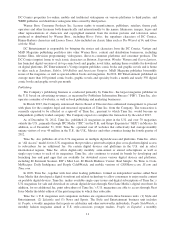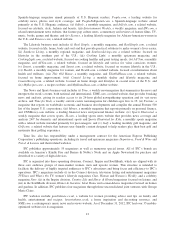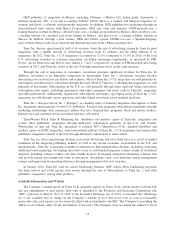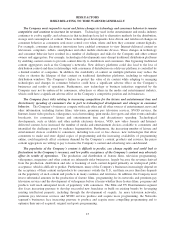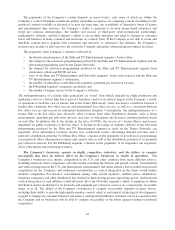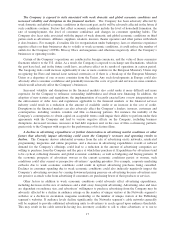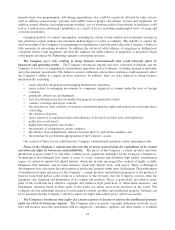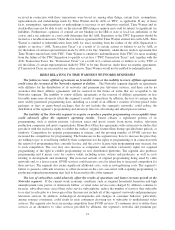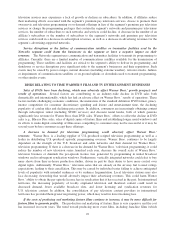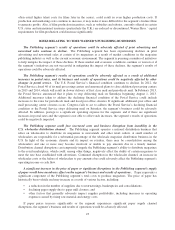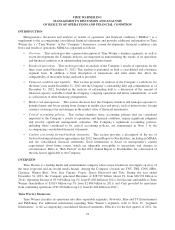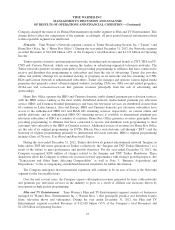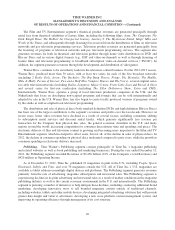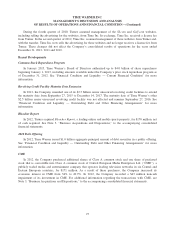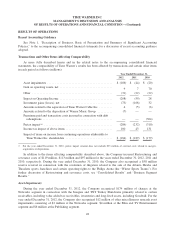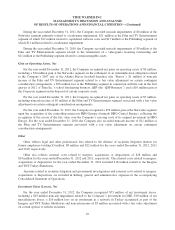Time Magazine 2012 Annual Report Download - page 35
Download and view the complete annual report
Please find page 35 of the 2012 Time Magazine annual report below. You can navigate through the pages in the report by either clicking on the pages listed below, or by using the keyword search tool below to find specific information within the annual report.and maintain its intellectual property rights in content, technology and products and services used to conduct its
businesses. However, the Company’s intellectual property rights, and its ability to license and exploit them in
accordance with past custom and practice, could be challenged or invalidated, it could have difficulty protecting
or obtaining such rights or the rights may not be sufficient to permit it to take advantage of business
opportunities, which could result in costly redesign efforts, discontinuance of certain product and service
offerings or other competitive harm. The Internet Corporation for Assigned Names and Numbers plans to expand
the Internet and has accepted over 1,900 applications for new generic top level domains (i.e., the names that
appear to the right of the period in domain names, such as .com, .net and .org), which could significantly change
the structure of the Internet and make it significantly more expensive for the Company to protect its intellectual
property on the Internet. Further, the laws of certain countries may not protect the Company’s proprietary rights
or such laws may not be strictly enforced, and the Company may be unable to protect its intellectual property
adequately against unauthorized copying or use in certain countries. In addition, there are legislative and
regulatory efforts under review in certain international territories, which, if successful, could reduce the
protection for the Company’s intellectual property and limit its ability to license its content.
The Company has been, and may be in the future, subject to claims of intellectual property infringement,
which could require the Company to change its business practices. Successful challenges to the Company’s
intellectual property could require the Company to enter into royalty or licensing agreements on unfavorable
terms, incur substantial monetary liability or be enjoined preliminarily or permanently from further use of the
intellectual property in question. This could require the Company to change its business practices and limit its
ability to compete effectively. Even if the Company believes that claims of intellectual property infringement are
without merit, defending against the claims can be time-consuming and costly and divert management’s attention
and resources away from its businesses.
The Company’s businesses are subject to labor interruption. The Company and certain of its suppliers
retain the services of writers, directors, actors, athletes, technicians, trade employees and others involved in the
development and production of feature films, television and digital programming and magazines who are covered
by collective bargaining agreements. If the Company or its suppliers are unable to renew expiring collective
bargaining agreements, it is possible that the affected unions could take actions in the form of strikes, work
slowdowns or work stoppages. Collective bargaining agreements with the American Federation of Musicians and
the Newspaper Guild of New York expire in early 2013 and agreements with the Writers Guild of America, West
Inc., the Writers Guild of America, East Inc., the Directors Guild of America and SAG-AFTRA expire in mid-
2014.
Strikes, work slowdowns or work stoppages or the possibility of such actions and attempts to unionize could
cause delays in the production or the release dates of the Company’s feature films, television and digital
programming and magazines. The Company could also incur higher costs from such actions, new collective
bargaining agreements or the renewal of collective bargaining agreements on less favorable terms. Many of the
Company’s collective bargaining agreements are industry-wide agreements, and the Company may lack practical
control over the negotiations and terms of these agreements. Union or labor disputes or player lock-outs relating
to professional sports leagues for which the Networks segment has the rights to produce and telecast live games
or events may preclude the Networks segment from telecasting scheduled games or events, which could have a
negative impact on the Networks segment’s revenues. Further, the loss of television programming due to such
disputes could negatively impact the segment’s promotional and marketing opportunities. Depending on its
duration, such a labor dispute could have an adverse effect on the Company’s businesses or results of operations.
A disruption or failure of the Company’s or its vendors’ information systems and networks as a result of
computer viruses, misappropriation of data or other malfeasance, natural disasters (including extreme
weather), accidental releases of information or other similar events, may disrupt the Company’s businesses,
damage its reputation or have a negative impact on its revenues. Because information systems, networks and
other technologies are critical to many of the Company’s operating activities, shutdowns or service disruptions at
the Company or vendors that provide information systems, networks or services to the Company pose increasing
risks. Such disruptions may be caused by events such as computer hacking, dissemination of computer viruses,
worms and other destructive or disruptive software, denial of service attacks and other malicious activity, as well
as power outages, natural disasters (including extreme weather), terrorist attacks, or other similar events. Such
19




